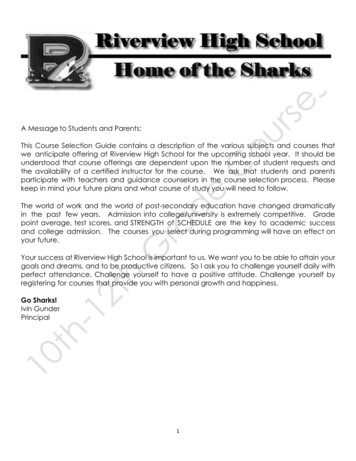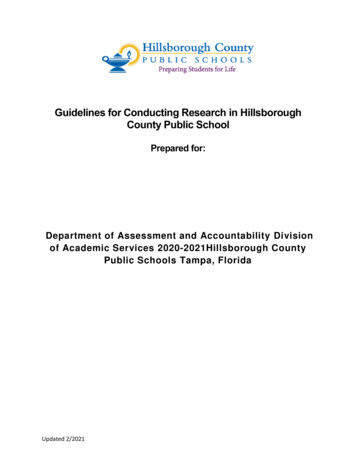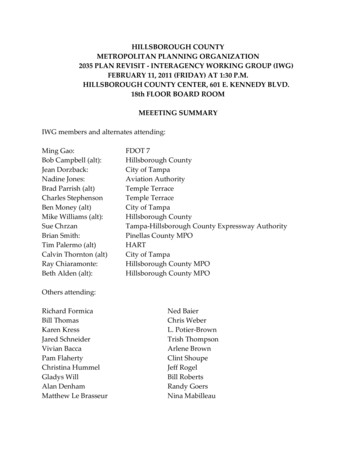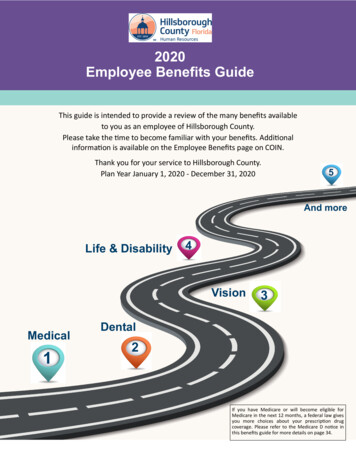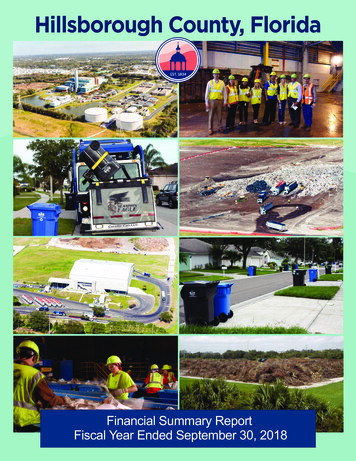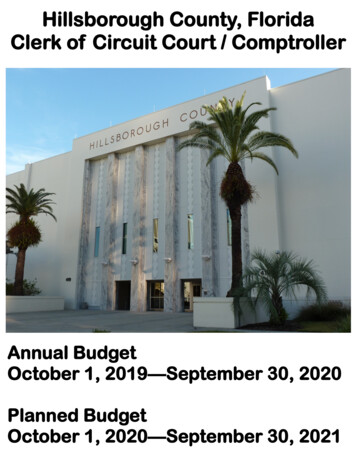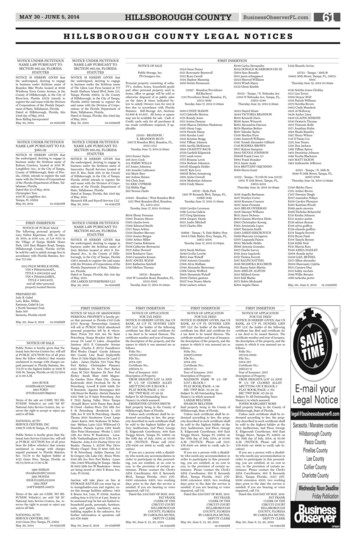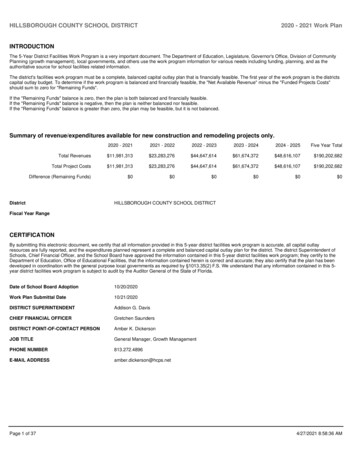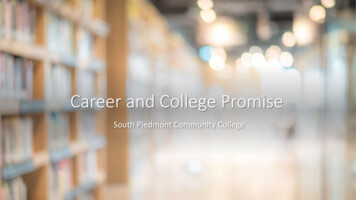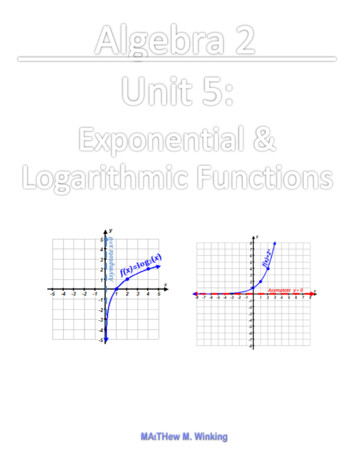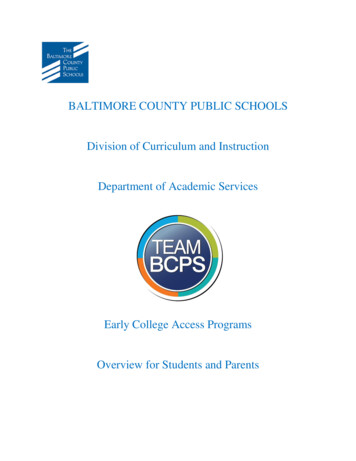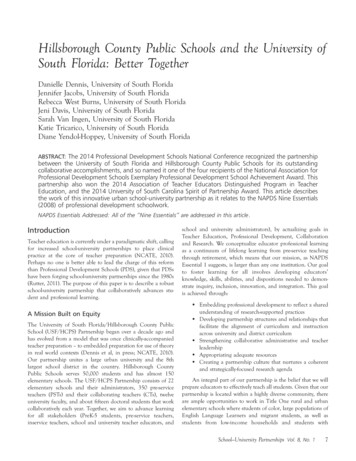
Transcription
Hillsborough County Public Schools and the University ofSouth Florida: Better TogetherDanielle Dennis, University of South FloridaJennifer Jacobs, University of South FloridaRebecca West Burns, University of South FloridaJeni Davis, University of South FloridaSarah Van Ingen, University of South FloridaKatie Tricarico, University of South FloridaDiane Yendol-Hoppey, University of South FloridaABSTRACT: The 2014 Professional Development Schools National Conference recognized the partnershipbetween the University of South Florida and Hillsborough County Public Schools for its outstandingcollaborative accomplishments, and so named it one of the four recipients of the National Association forProfessional Development Schools Exemplary Professional Development School Achievement Award. Thispartnership also won the 2014 Association of Teacher Educators Distinguished Program in TeacherEducation, and the 2014 University of South Carolina Spirit of Partnership Award. This article describesthe work of this innovative urban school-university partnership as it relates to the NAPDS Nine Essentials(2008) of professional development schoolwork.NAPDS Essentials Addressed: All of the ‘‘Nine Essentials’’ are addressed in this article.IntroductionTeacher education is currently under a paradigmatic shift, callingfor increased school-university partnerships to place clinicalpractice at the core of teacher preparation (NCATE, 2010).Perhaps no one is better able to lead the charge of this reformthan Professional Development Schools (PDS), given that PDSshave been forging school-university partnerships since the 1980s(Rutter, 2011). The purpose of this paper is to describe a robustschool-university partnership that collaboratively advances student and professional learning.school and university administrators), by actualizing goals inTeacher Education, Professional Development, Collaborationand Research. We conceptualize educator professional learningas a continuum of lifelong learning from pre-service teachingthrough retirement, which means that our mission, as NAPDSEssential 1 suggests, is larger than any one institution. Our goalto foster learning for all involves developing educators’knowledge, skills, abilities, and dispositions needed to demonstrate inquiry, inclusion, innovation, and integration. This goalis achieved through: A Mission Built on EquityThe University of South Florida/Hillsborough County PublicSchool (USF/HCPS) Partnership began over a decade ago andhas evolved from a model that was once clinically-accompaniedteacher preparation – to embedded preparation for use of theoryin real world contexts (Dennis et al, in press; NCATE, 2010).Our partnership unites a large urban university and the 8thlargest school district in the country. Hillsborough CountyPublic Schools serves 50,000 students and has almost 150elementary schools. The USF/HCPS Partnership consists of 22elementary schools and their administrators, 350 pre-serviceteachers (PSTs) and their collaborating teachers (CTs), twelveuniversity faculty, and about fifteen doctoral students that workcollaboratively each year. Together, we aim to advance learningfor all stakeholders (PreK-5 students, pre-service teachers,inservice teachers, school and university teacher educators, and Embedding professional development to reflect a sharedunderstanding of research-supported practicesDeveloping partnership structures and relationships thatfacilitate the alignment of curriculum and instructionacross university and district curriculumStrengthening collaborative administrative and teacherleadershipAppropriating adequate resourcesCreating a partnership culture that nurtures a coherentand strategically-focused research agendaAn integral part of our partnership is the belief that we willprepare educators to effectively teach all students. Given that ourpartnership is located within a highly diverse community, thereare ample opportunities to work in Title One rural and urbanelementary schools where students of color, large populations ofEnglish Language Learners and migrant students, as well asstudents from low-income households and students withSchool—University Partnerships Vol. 8, No. 17
8DANIELLE DENNIS ET AL.Partnership Pathway 2: Elementary CohortPartnership Pathway (CPP)Figure 1.Two Pathways to Teacher Certificationdisabilities comprise a large portion of the population. We arecommitted to supporting educators in being successful bybecoming culturally responsive, and we seek to develop acommitment to working with diverse populations.One Partnership: Two Pathways toCertificationIn an effort to create a fertile context for fostering learning, theUSF/HCPS Partnership has collaboratively designed twopathways to elementary certification (Figure 1). These pathwaysare intentionally designed to meet different but important needsthat when combined, create an innovative partnership for a fulltime, undergraduate program.Partnership Pathway 1: Urban Teacher ResidencyPartnership Pathway (UTRPP)UTRPP is a two-year, intensive, residency experience in whichpre-service teachers’ coursework is embedded in field experiences. Residents are located in six urban schools near USF. Theschools range in size from approximately 250 students to 1200students. Collectively, these six schools work intensively to createone UTRPP community.There are two cohorts of 25-35 residents each operating atany one time, totaling between 50-60 residents in the program.All residents are contracted 7:30 – 3:30, mirroring HillsboroughCounty Public Schools (HCPS) teacher contracts. In their firstyear as juniors, residents are in schools five days per week abouthalf a day each day equating to 20-25 hours per week. The otherhalf of their time, they are in university coursework. In theirfinal year as seniors, they adopt the HCPS calendar and begin inAugust with a collaborative professional development workshop.Principals welcome them as staff members in their schoolcommunities offering equal access to all professional development opportunities within the school. Residents spend four tofive full days per week in the classroom with a half-day ofcoursework equating to 30þ hours per week of clinicalexperience. Upon graduation, residents have almost 2000 hoursof clinical preparation.The elementary cohort pathway (CPP) is the largest programwithin the department and college, with over 300 pre-serviceteachers simultaneously progressing through a five-semestersequence. Whereas UTRPP coursework is primarily taught byfaculty, the CPP coursework is primarily taught by graduatestudents. CPP includes coursework coupled with field experiences within each semester at sixteen specifically selectedpartnership schools. Fifteen PSTs are adopted by each schooland spend their first four semesters working in various gradelevels at the same partnership school. In the first year CPPinterns spend one day a week in the same classroom. In the fallof the second year, the CPP interns switch classrooms and spendtwo back-to-back days in the school. Interns have the option inthe final semester to remain in their school or change to anotherschool for their final internship. In total, interns spendapproximately 1000 hours in the field across the program. LikeUTRRP, opportunities to stay within the same school allow PSTsto build understanding of the school culture, resources,curriculum approaches, diverse students, and the micropoliticsof schools.In SummaryAs NAPDS Essential 2 suggests, interns in both pathways areactively engaged in the school communities. They attend openhouse and curriculum nights at their schools and participate infaculty/team meetings and Professional Learning Communities.We position the UTRRP as a specifically developed site forresearch and innovation in teaching and teacher education. TheCPP serves as an equally important innovation site as it providesa research context for enhancing school-based teacher education,increasing the use of teacher inquiry as a professional learningand school improvement tool as well as preparing the nextgeneration of teacher educators, our doctoral students.Guiding Principles Across PathwaysEven though our partnership has two pathways, we have specificguiding principles that traverse the pathways and unite thepartnership.Conceptual FrameworkBoth pathways are guided by the elementary program’sconceptual framework consisting of the four I’s—Inquiry,Inclusion, Integration, and Innovation—as well as the FloridaEducator Accomplished Practices (http://www.fldoe.org/profdev/FEAPs/). The four I’s are threaded through eachpathway’s coursework and fieldwork. This integration isnecessary for coherence and requires strong collaborationbetween school and university teacher educators, makingpartnership an important hallmark of our work.
Better TogetherSignature PedagogyNAPDS Essential 4 states that PDSs attend to innovativepractices. In our program, we have signature pedagogies(Shulman, 2005) that are congruent with signature pedagogiesin PDSs (Yendol-Hoppey & Franco, 2014) that foster innovativepractices. These signature pedagogies include integrated coursework and fieldwork, teacher inquiry, and peer observationamong others.Integrated coursework and fieldwork. The integration of coursework and fieldwork requires collaborative coursework development. USF faculty and HCPS teachers, administrators, andcurriculum supervisors planned the original scope and sequenceof our programs. University methods faculty work with principals,teachers, and curriculum supervisors on methods syllabi/assignments on a regular basis. Partners provide feedback onwhether what faculty are asking students to do is helpful in theclassroom. School faculty and principals join the methods facultyin instruction during various classes throughout the semester.Faculty also meet with the HCPS science, math, reading, andwriting supervisors to discuss course components and are invitedto attend district trainings to support the faculty’s understandingof district-wide initiatives across subject areas.In addition to the formal curriculum design, fieldsupervisors (graduate students and partnership resource teachers) meet regularly with collaborating teachers (CTs) (once permonth in UTRPP, twice per semester in CPP). During thesemeetings, syllabi and course assignments are discussed toidentify successes and challenges. Additionally, during thesemeetings, CTs indicate what they believe expectations should beduring the field experience and help co-construct theseexpectations for the interns. One uniting experience across thepathways is the HCPS STEM Fair where interns and residentsreceive district training in their methods coursework to serve asjudges. Our attention to integrating coursework and fieldworkrequires constant attention but is critical to our goal of improvedlearning for all stakeholders.Teacher inquiry. Teacher inquiry involves educators systematically studying their practice (Dana & Yendol-Hoppey, 2014).Within and across both the UTRPP and CPP pathways, inquiry ispurposefully integrated and scaffolded. Teacher inquiry begins thepre-service teachers’ first semester by looking at an individualstudent and continues through the two-year program culminating ina self-selected inquiry question. We encourage pre-service teachers,collaborating teachers, principals, and faculty to study their practiceas a means for determining impact on student learning.We work to share inquiry practices across the partnershipthrough the annual USF Teacher Inquiry Conference with thegoal of sharing the inquiries of PSTs, CTs, faculty, and schoolpartners. This setting is a place for stakeholders working inindividual settings to learn from and with those working acrossthe partnership. This encourages cross-school collaborations,and brings to the forefront the number of stakeholders engagedin PDS work across USF/HCPS. In 2013 alone, stakeholderswere involved in over 185 presentations at the conference. Each9year, we award individuals who are committed to the partnershipand to teacher inquiry as a signature pedagogy of PDS work.Multi-faceted supervision plan. We have developed a robust,multi-faceted supervision plan comprised of both coaching andassessment processes. We use a well-defined set of tools tosupport PST learning and assess PST development.Within UTRPP, there is a content coaching initiative thatsupports collaborating teachers’ and residents’ pedagogicalcontent knowledge in science, math, and literacy. Faculty withexpertise in the areas of literacy, science, and mathematics notonly teach coursework in those areas, but also engage in one-onone coaching with PSTs to support the development of theirpedagogical content knowledge. Partnership Resource Teacherssupport content coaching by collaborating with the contentcoaches and offering supervision support to the residents andcollaborating teachers. In order to develop pedagogical contentknowledge, content coaching places the elementary student atthe center of this work, with the intention of understanding howcontent learning best supports student learning. Additionally,faculty work closely with district supervisors in each content areato ensure that a shared language is used. The in-tandem use ofcontent coaches and Partnership Resource Teachers as fieldsupervisors provides a comprehensive supervision plan forUTRPP.While content coaching does not currently occur in the CPP,this pathway has been purposeful in assigning field supervisors tosimultaneously serve as methods’ instructors. This dual role allowsdeeper theory-to-practice and practice-to-theory connections as thefield supervisors have intimate knowledge of the school contextsand the teacher education curriculum. These field supervisors staywith the same group of interns over several semesters. This allowssupervisors to build relationships with school partners and gain adeep understanding of their interns’ needs.On-going Research for Program ImprovementThe USF/HCPS Partnershi
between the University of South Florida and Hillsborough County Public Schools for its outstanding collaborative accomplishments, and so named it one of the four recipients of the National Association for Professional Development Schools Exemplary Professional Development School Achievement Award. This partnership also won the 2014 Association of Teacher Educators Distinguished Program in .
